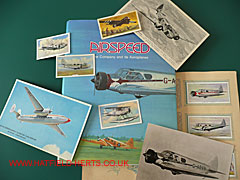 Airspeed Limited
Airspeed Limited
Started by former employees of the de Havilland Aircraft Company at the start of the Thirties, Airspeed only lasted 20-years before it was absorbed into the de Havilland group. However, it produced some remarkable aircraft, like the Courier, Envoy, Oxford, Horsa glider, and the Ambassador, to ensure its place in aviation and Hatfield history.
Airspeed was the brainchild of two former de Havilland Aircraft Company (DHAC) employees who had moved across to the Airship Guarantee Company, a Vickers subsidiary.
Although they successfully built an airship, the R.100, capable of crossing the Atlantic the company was doomed by the crash of a rival craft, the R.101. Airships went out of fashion – the company was closed down and its workforce faced unemployment.
Against the odds, Alfred Hessell Tiltman and Nevil Shute Norway convinced Lord Grimthorpe, a solicitor A E Hewitt and the already famous aviator, Alan Cobham to invest and become board members of of the fledgling company.
Geoffrey de Havilland sent them a good wishes telegram when the company was founded.
Strapped for cash from the outset (and for a number of years afterwards) they first built a glider and then powered aircraft. Realising with their limited means that they had no chance of competing with the established firms (like de Havillands) from the start they strove to come up with innovative designs.
The Courier became the first British aircraft to feature retractable undercarriage (and they tried to sue DHAC for patent infringement after the DH.88 Comet Racer came out the following year).
However, in what today seems like an echo of history, a depression in the States impacted on UK economic activity. The initial company was wound up and a new one created with directors from a firm of wealthy shipbuilders added to the board.
Unfortunately, there was little that they could add apart from money. A promising deal with Fokker ultimately yielded little tangible benefits. The shipbuilders soon lost interest and sold their stakes – to DHAC.
Although the success of the Envoy and a substantial order for the Oxford trainer derivative had by then established the company's reputation, internal differences led to the departure of N S Norway – to pursue a successful career as the author under his forenames: Nevil Shute – before DHAC took charge after WWII had started, and added their own directors to the board. By 1942 the last of the original board members had left.
Airspeed made a significant contribution during WWII as the twin engine Oxford was the standard RAF trainer for bomber pilots. However, their greatest impact was through Fireproof Tanks Ltd – a subsidiary (established in 1939, and that survives to this day). They made self sealing fuel tanks that saved the lives of countless pilots and their crews.
Postwar, Airspeed's last great hope, the Ambassador was dogged by a dithering client and technical glitches. The moment was gone – Vickers Varsity and DHAC's own DH.106 Comet jet airliner entered the scene. Airspeed was absorbed into DHAC in 1951 – a fate that was to later befall DHAC and others till civilian aircraft manufacturing in Britain was all but wiped out. Today little remains of a golden age.
Airspeed timeline
A timeline of key events in the Airspeed story.
Click here for Airspeed timeline (1930 - 1939)
Click here for Airspeed timeline (1940 - 1968)
Some of the key Airspeed designs
Although it only lasted for a couple of decades, Airspeed made its mark in aviation history with a handful of designs. If the economy had been in better shape things may well have turned out differently..
Key achievements and 'firsts'
Airspeed knew it had to be different to break into a competitive market dominated by established names. Innovative design and radical thinking were its answer.
Some of the people in the Airspeed story
A brief look at some of the remarkable people (other than test pilots) who feature in the Airspeed story
Airspeed test pilots
Early test pilots tended to be larger than life characters – often rightly portrayed as being cast of a heroic mould. In advancing human development they took some frightful risks – many did not survive to draw their pension. Airspeed was no exception.
Hatfield footnotes
Although Airspeed started life in York before moving to Portsmouth, Hatfield played a significant role in the company's history. Sadly, it wasn't always a happy one.
Books used to research this section can be found in the Aviation and Aerospace books page (in the Books, Films and TV section)
Back to: Aviation and Aerospace